A response to "why are 18s *slow* "
Committees, have you read all the posts before my post#41 ?
What I wrote in #41 was a response to the previous posts and those who think 18s can be as fast as or even faster than smaller ones.
Can anyone tell me what's wrong in the quotes above?
Is it really impossible to take a workable angle to comprehend my post? (or hairsplitting is more fun?)
Size does matter, in everything. That's just a simple and fundamental principle in the whole universe.
------------------
"Bigger woofers don't have to be fast, other factors in the system also matter...." are not the answer to the original question "why are 18s slow".
Why do you keep avoiding the question itself?
It's just about how they move and stop.
Can anyone show me some CSD which can demonstrate the 18s can have cleaner decay than a smaller driver? Or 18s can have a higher amplitude/rise time ratio in step response, and meantime maintain the same low distortion (usability) of that initial attack?
If you can, take the next step: applying all possible technologies of that 18s to an 8" and optimize them, then do the comparison again.
-----------------
I don't 'hate' big woofers. It's just I have to accept their limits. I have been using 18" woofers in my own system for over 15 years, but I don't have to defend for their shortcomings, or defend myself being using them.
And in the last several months, I started using very large stuff for wide band application (including the very top HF). So that question of 18s for tweeter is serious (or it's also like a test). I know you guys are not ready for it, yet. So I agree (finally there's one thing) not to waste time anymore.
Committees, have you read all the posts before my post#41 ?
What I wrote in #41 was a response to the previous posts and those who think 18s can be as fast as or even faster than smaller ones.
No one mentioned about the proportion issue in nature.
...
It's all about compromises for the applications. ...
Can anyone tell me what's wrong in the quotes above?
Is it really impossible to take a workable angle to comprehend my post? (or hairsplitting is more fun?)
Size does matter, in everything. That's just a simple and fundamental principle in the whole universe.
------------------
"Bigger woofers don't have to be fast, other factors in the system also matter...." are not the answer to the original question "why are 18s slow".
Why do you keep avoiding the question itself?
It's just about how they move and stop.
Can anyone show me some CSD which can demonstrate the 18s can have cleaner decay than a smaller driver? Or 18s can have a higher amplitude/rise time ratio in step response, and meantime maintain the same low distortion (usability) of that initial attack?
If you can, take the next step: applying all possible technologies of that 18s to an 8" and optimize them, then do the comparison again.
-----------------
I don't 'hate' big woofers. It's just I have to accept their limits. I have been using 18" woofers in my own system for over 15 years, but I don't have to defend for their shortcomings, or defend myself being using them.
And in the last several months, I started using very large stuff for wide band application (including the very top HF). So that question of 18s for tweeter is serious (or it's also like a test). I know you guys are not ready for it, yet. So I agree (finally there's one thing) not to waste time anymore.
We read it and broke it down. I don't think I need waste any time with rhetoric until you respond to our posts in kind.Committees, have you read all the posts before my post#41 ?
What I wrote in #41 was a response to the previous posts and those who think 18s can be as fast as or even faster than smaller ones.
Can anyone tell me what's wrong in the quotes above?
Is it really impossible to take a workable angle to comprehend my post? (or hairsplitting is more fun?)
Size does matter, in everything. That's just a simple and fundamental principle in the whole universe.
------------------
"Bigger woofers don't have to be fast, other factors in the system also matter...." are not the answer to the original question "why are 18s slow".
Why do you keep avoiding the question itself?
It's just about how they move and stop.
Can anyone show me some CSD which can demonstrate the 18s can have cleaner decay than a smaller driver? Or 18s can have a higher amplitude/rise time ratio in step response, and meantime maintain the same low distortion (usability) of that initial attack?
If you can, take the next step: applying all possible technologies of that 18s to an 8" and optimize them, then do the comparison again.
-----------------
I don't 'hate' big woofers. It's just I have to accept their limits. I have been using 18" woofers in my own system for over 15 years, but I don't have to defend for their shortcomings, or defend myself being using them.
Sorry, I didn't realize you were so much smarter than us. Let's be on our way, then.And in the last several months, I started using very large stuff for wide band application (including the very top HF). So that question of 18s for tweeter is serious (or it's also like a test). I know you guys are not ready for it, yet. So I agree (finally there's one thing) not to waste time anymore.
Last edited:
.
~~~~~~~~~~~~~non-essential wording snipped~~~~~~~~~~~
So I agree (finally there's one thing) not to waste time anymore.
Then a state of equilibrium has finally been reached and everyone's happy.
Best Regards,
TerryO
CLS, the internet is a great place to get accidentally misinterpreted.
Now, some of us might be science geeks (in our spare time 😉 )....not too keen on ambiguity, happy to attack ideas, not always focussed on the mess it may cause...
...but if you stay on topic, why shouldn't we? and if we don't then it's your choice whether to go that way.
I wouldn't mind hearing your thoughts on an 18" tweeter, even if they are not "ready for production".
Now, some of us might be science geeks (in our spare time 😉 )....not too keen on ambiguity, happy to attack ideas, not always focussed on the mess it may cause...
...but if you stay on topic, why shouldn't we? and if we don't then it's your choice whether to go that way.
I wouldn't mind hearing your thoughts on an 18" tweeter, even if they are not "ready for production".
i think that is why lab sub wins all shoot outs in terms of low distortion. because it uses 12" also danleys th 812 maybe the same
"danleys th 812 maybe the same "
Those drivers are mounted push-pull for distortion reduction.
http://i959.photobucket.com/albums/ae76/fullrangebates/002.jpg
A 28hz PPSL pair of 18's that sound 'faster' than a set of three 10's in a sealed enclosure.
Those drivers are mounted push-pull for distortion reduction.
http://i959.photobucket.com/albums/ae76/fullrangebates/002.jpg
A 28hz PPSL pair of 18's that sound 'faster' than a set of three 10's in a sealed enclosure.
Brief Acoustics Review
According to Newton [F] = [M]*[A] and the answer to the question long over due is: [A] = [F]/[M]. So, a wimpy motor yields a "slow" driver. What is overlooked here is what happens when the drive signal goes towards a zero value? What is perceived as "Fast" may well be overshoot and ringing. N.B.: a big [F] leads to a minimized [Q] and that driver is not "slow". For a big surface radiating high frequencies, use a electrostatic design. WHG
According to Newton [F] = [M]*[A] and the answer to the question long over due is: [A] = [F]/[M]. So, a wimpy motor yields a "slow" driver. What is overlooked here is what happens when the drive signal goes towards a zero value? What is perceived as "Fast" may well be overshoot and ringing. N.B.: a big [F] leads to a minimized [Q] and that driver is not "slow". For a big surface radiating high frequencies, use a electrostatic design. WHG
According to Newton [F] = [M]*[A] and the answer to the question long over due is: [A] = [F]/[M]. So, a wimpy motor yields a "slow" driver. What is overlooked here is what happens when the drive signal goes towards a zero value? What is perceived as "Fast" may well be overshoot and ringing. N.B.: a big [F] leads to a minimized [Q] and that driver is not "slow". For a big surface radiating high frequencies, use a electrostatic design. WHG
meaning that a 42"driver driven with 20k watt motor can be clear and low in distortion like a good 12"or a 10"woofer .😕😕
below links to the 22"and 42"powersoft mdrive drivers driven with more than 13,000watts
Powersoft to demonstrate its M-Force System in LA
ATK Audiotek Adopts Powersoft M-System - FRONT of HOUSE
Powersoft to Exhibit M-System at ALMA Winter Symposium
Powersoft Audio - Home
Attachments
-
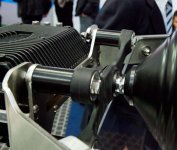 Powersoft-M-trans.jpg76.8 KB · Views: 280
Powersoft-M-trans.jpg76.8 KB · Views: 280 -
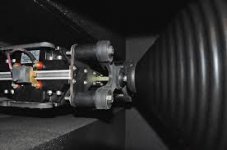 images (3).jpg6 KB · Views: 254
images (3).jpg6 KB · Views: 254 -
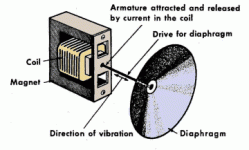 crowhurst_basic_audio_vol1-75.gif14.5 KB · Views: 271
crowhurst_basic_audio_vol1-75.gif14.5 KB · Views: 271 -
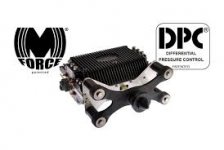 images (1).jpg6.8 KB · Views: 258
images (1).jpg6.8 KB · Views: 258 -
 images.jpg9.5 KB · Views: 256
images.jpg9.5 KB · Views: 256 -
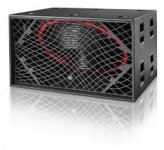 download (2).jpg9.8 KB · Views: 127
download (2).jpg9.8 KB · Views: 127 -
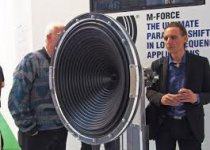 download (1).jpg9.8 KB · Views: 116
download (1).jpg9.8 KB · Views: 116 -
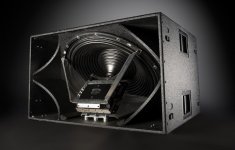 Powersoft-M-Force-System.jpg66.6 KB · Views: 127
Powersoft-M-Force-System.jpg66.6 KB · Views: 127
Didn´t read the thread but putting too much eq to sealed 18" (any sealed) usually causes little big slugginess to bass section
Didn´t read the thread but putting too much eq to sealed 18" (any sealed) usually causes little big slugginess to bass section
Yes, to some degree. But correct EQing actually improves transient behaviour. But you will still find those who say that the bass "sounds slow" as soon as they can hear the fundamentals (which often have longer decay times than higher parts of the spectrum). Those are the ones who are talking of fast bass when the reproduction is actually incorrect and lacking. A speaker with higher cutoff frequency does even have more group-delay distortion where it actually counts.
When two speakers have the same frequency response (which includes amplitude and phase !!) at their lower cutoff they have a chance of having the same transient properties even when one is an 8" and the other one is an 18". But they might differ at their top end however. So the 18" might most probably need a lower crossover frequency than the 8" and thus making the system group delay distortion higher in some cases. But that is dependant on the crossover topology used.
Therefore a blanket statement that 18"ers are "slow" is wrong IMO.
Regards
Charles
Last edited:
People use the wrong adjective (slow) to describe a certain quality of a loudspeaker.
Being slow is directly connected to being of lower sensitivity. We need more
information on what seems to be the issue.
Being slow is directly connected to being of lower sensitivity. We need more
information on what seems to be the issue.
slow and sensitivity are different .meaning smaller drivers have less or smaller sensitivity and they are the ones regarded as fast.
The Mass Corner used in horn calculations gives a good idea on how 'fast' a woofer is. It is a combination of the mass of the driver, and the force available to drive it.
Well, it defines the transition point from the acceleration (rising response) BW, which is a function of / dominated by Q, and the mass-controlled (flat) BW, which unsurprisingly is dominated by mass, until VC inductance rolls the response off. This of course assumes pistonic behaviour which is at best a dodgy analogy and does not account for controlled resonance which many drivers use to extend their BW. Since this is about 18in units, that last can be essentially written off as their primary purpose is to move large quantities of air. Mass corner [Fhm] = 2Fs/[effective] system Q.
Any competently designed 18in driver should not be 'slow' any more than it should not be 'fast'. It should accurately track the LF frequency fed to it (not actually all that difficult given that by definition LF frequencies are 'slow'. Otherwise they would be high frequencies 😉 ) up to the effective upper limit of the XO transition band. If a competently designed 18in woofer sounds slow, it's either in an ineptly designed enclosure, combined to other units with an ineptly designed XO, or both.
Any competently designed 18in driver should not be 'slow' any more than it should not be 'fast'. It should accurately track the LF frequency fed to it (not actually all that difficult given that by definition LF frequencies are 'slow'. Otherwise they would be high frequencies 😉 ) up to the effective upper limit of the XO transition band. If a competently designed 18in woofer sounds slow, it's either in an ineptly designed enclosure, combined to other units with an ineptly designed XO, or both.
FAST - the one word responsible for more confusion about bass than any other, rivaled only by the word SLOW.
The experience is real. You hear something you describe as fast or slow and it seems to correspond with something easy to blame. It might be the size of the woofer, its heavy mass or some other property like its efficiency. We all like quick easy to understand answers but as Mencken is often eloquently quoted, those tend to also be wrong.
In a bass horn, a smaller driver means a smaller horn. The choice of driver size is a logistics problem above all else. Once you've chosen the extension required, you choose the driver size that results in an acceptable size. Whether you use a 12" or an 18" driver has no direct connection to subjective speed. A bass horn requires a relatively steep filter and narrow pass band. You are forced to do so by resonances above the useful pass band. If your low pass filter is not set low and/or steep enough, they will be audible and the result is inferior to a sealed or ported box. Your sub comes to resemble a power tool and you don't get the benefit you went to all that trouble to achieve, with a more complex box build and a back breaking enclosure.
If you get everything right, a horn sub will disappear and all you will hear is effortless and clean bass.
When we talk about "fast" it's not clear what is meant. That's the problem we hit every time this topic comes up, if we want to have an objective discussion. If we are talking about the rise time of the impulse response, then neither SD (piston area) nor mms (moving mass) are causal factors. You can mass load the cone until the sensitivity suffers considerably and yet the rise time is not changed at all. Here is an example:

The two impulse responses have been overlaid. In this example, the sensitivity was reduced by 3 dB.
Now watch what happens when we add a 2.5 mH inductor:

We get an identical result where we apply a low pass with an active filter.
It is the high frequency response of the woofer that provides a short rise time. The fastest woofer in this regard is one with the greatest high frequency extension. This would be a full range driver.
In the context of a subwoofer, all this is irrelevant. As soon as we add a lowpass filter to achieve a target response, all that fast bass disappears. The impulse response is dominated entirely by the response shape of the acoustic low pass frequency response. The steeper the slope and the lower the corner frequency, the longer the rise time. The filter itself becomes the dominant factor.
What we see looks more like this:


These were taken from an article I wrote for StereoNET:
The Fast Bass Experiment - Are Heavy Woofers Slow? | StereoNET
The key point here is that we need to put more focus into the more critical aspects like room acoustics and integration/calibration and lose the idea that little woofers are going to offer something magical. Get the critical things right and your ears will have no idea what size woofer you are using.
The experience is real. You hear something you describe as fast or slow and it seems to correspond with something easy to blame. It might be the size of the woofer, its heavy mass or some other property like its efficiency. We all like quick easy to understand answers but as Mencken is often eloquently quoted, those tend to also be wrong.
i think that is why lab sub wins all shoot outs in terms of low distortion. because it uses 12" also danleys th 812 maybe the same
In a bass horn, a smaller driver means a smaller horn. The choice of driver size is a logistics problem above all else. Once you've chosen the extension required, you choose the driver size that results in an acceptable size. Whether you use a 12" or an 18" driver has no direct connection to subjective speed. A bass horn requires a relatively steep filter and narrow pass band. You are forced to do so by resonances above the useful pass band. If your low pass filter is not set low and/or steep enough, they will be audible and the result is inferior to a sealed or ported box. Your sub comes to resemble a power tool and you don't get the benefit you went to all that trouble to achieve, with a more complex box build and a back breaking enclosure.
If you get everything right, a horn sub will disappear and all you will hear is effortless and clean bass.
When we talk about "fast" it's not clear what is meant. That's the problem we hit every time this topic comes up, if we want to have an objective discussion. If we are talking about the rise time of the impulse response, then neither SD (piston area) nor mms (moving mass) are causal factors. You can mass load the cone until the sensitivity suffers considerably and yet the rise time is not changed at all. Here is an example:

The two impulse responses have been overlaid. In this example, the sensitivity was reduced by 3 dB.
Now watch what happens when we add a 2.5 mH inductor:

We get an identical result where we apply a low pass with an active filter.
It is the high frequency response of the woofer that provides a short rise time. The fastest woofer in this regard is one with the greatest high frequency extension. This would be a full range driver.
In the context of a subwoofer, all this is irrelevant. As soon as we add a lowpass filter to achieve a target response, all that fast bass disappears. The impulse response is dominated entirely by the response shape of the acoustic low pass frequency response. The steeper the slope and the lower the corner frequency, the longer the rise time. The filter itself becomes the dominant factor.
What we see looks more like this:


These were taken from an article I wrote for StereoNET:
The Fast Bass Experiment - Are Heavy Woofers Slow? | StereoNET
The key point here is that we need to put more focus into the more critical aspects like room acoustics and integration/calibration and lose the idea that little woofers are going to offer something magical. Get the critical things right and your ears will have no idea what size woofer you are using.
Hey Paul thanks for that, very clear. I was happy to see your post, having not seen you on the forum in a long time. Turns out we just aren't in the same threads.
I wonder if some of the fast vs slow doesn't partly come from settling time and resonances. Things that are not difficult to measure. For example, the old P.Audio 18" coax is not a slow sounding 18", quite the contrary - it's fast, snappy and dynamic. I might be able to get a look at that, if it's interesting to anyone.
I wonder if some of the fast vs slow doesn't partly come from settling time and resonances. Things that are not difficult to measure. For example, the old P.Audio 18" coax is not a slow sounding 18", quite the contrary - it's fast, snappy and dynamic. I might be able to get a look at that, if it's interesting to anyone.
I'd like to post more often but I have very limited time these days.
Regarding your 18" coax woofer, the fact that it is a coax means it would satisfy the criteria for a short rise time by design. To work as a coax, it requires good top end extension to cross to a compression driver. You've eliminated the mid to woofer crossover which is often a chance for things to go wrong.
It would be an interesting study, but the challenge is to make "all else equal."
I'd also consider the context. Whether in a domestic room, where the decay is dominated by room resonances, or a large pro sound venue or an outdoor pro sound situation. All quite different.
Regarding your 18" coax woofer, the fact that it is a coax means it would satisfy the criteria for a short rise time by design. To work as a coax, it requires good top end extension to cross to a compression driver. You've eliminated the mid to woofer crossover which is often a chance for things to go wrong.
I wonder if some of the fast vs slow doesn't partly come from settling time and resonances.
It would be an interesting study, but the challenge is to make "all else equal."
I'd also consider the context. Whether in a domestic room, where the decay is dominated by room resonances, or a large pro sound venue or an outdoor pro sound situation. All quite different.
- Status
- Not open for further replies.
- Home
- Loudspeakers
- Multi-Way
- why are 18s *slow*